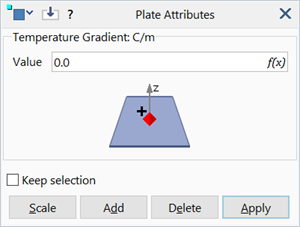Plate Attributes: Temperature Gradient

Description
Assigns a temperature gradient attribute to selected plate elements.
A temperature gradient defines a linear variation of temperature in the through-thickness direction of the plate, positive towards the +z axis.
The temperature variation generates a curvature in the plate. It does not produce in-plane strain in non-offset plates. In-plane thermal expansion of plates is generated by the presence of nodal temperatures.
A positive gradient corresponds to an increasing temperature from the negative side to the positive side, so the positive side is expanding relative to the negative side.
A negative gradient corresponds to a decreasing temperature from the negative side to the positive side, so the positive side is contracting relative to the negative side.
This attribute is used only by the structural solvers; it is not applicable to heat transfer analysis.
Temperature gradient attributes are load case dependent.
Dialog
Value
Temperature gradient between the two plate surfaces.
Common Controls
Units
Temperature/Length (e.g., °C/m, °F/in).
Common Uses
Some structural design codes require that structures such as bridges be designed for a difference in temperature through the thickness, such as would occur when the sun is shining on one surface only.
See Also